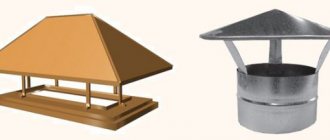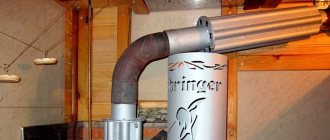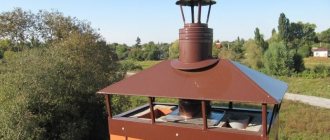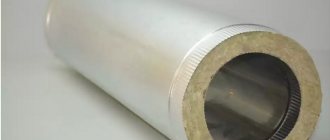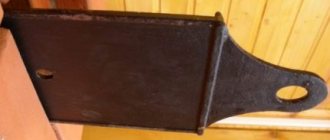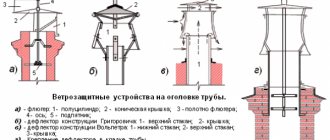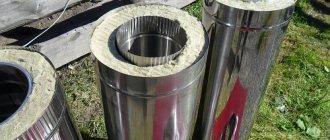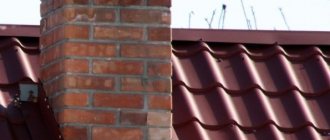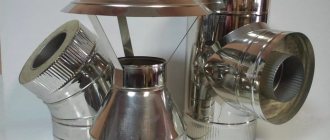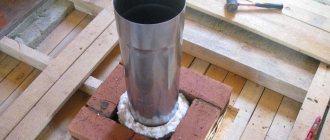A chimney-convector, or in other words an economizer, serves as a device that increases the efficiency of stoves with a low spectrum of action. Such a system finds beneficial application in cases where extensions that require heating are added to the original dimensions of the room. Thus, instead of replacing the unit, the unused resources of the existing coolant are used, which are advantageously distributed to heat the added area.
This system also has a number of other useful qualities. It acts as a screen that protects the exhaust pipe from infrared radiation that comes from the heated surface. Plus, this device is quite easy to install and unpretentious in operation, and also does not require a built-in fan, excluding connection to the mains.
What materials are used?
Modern devices, which are installed on heating devices instead of a chimney, are made from high-quality materials - high-alloy steel. It must be heat-resistant in order to withstand the effects of high temperatures that are formed from the influence of hot gases from the heating system.
Double wall chimney
The chromium content in such an alloy should reach 13%. Also, the metal for the device must have anti-corrosion properties and be resistant to aggressive acids.
In rare cases, the outer surface of the convector chimney is made of bush hammered stone, jadeite, marble, soapstone. This option is no less advantageous, since natural material promotes uniform distribution of thermal energy and its accumulation inside the housing.
Expert advice
Experts in chimneys of heating systems in suburban buildings recommend purchasing high-quality economizers from trusted manufacturers - i.e. Don't skimp on the device. According to their opinion, the optimal solution for supplementing a stationary flue system with a convector would be professional implementation of the installation, as well as subsequent maintenance of the device.
A convector chimney is a safe and inexpensive device that can increase the efficiency of a heating system without increasing the financial costs of its operation. Devices of this type are characterized by durability and simplicity of design, which allows you to assemble and install them yourself and forget about replacing or major repairs of the gas exhaust system for a decade.
Now you know how to make your oven work 100% without major investment. Subscribe to our articles and share useful information with friends. See you again!
(
2 ratings, average: 5.00 out of 5)
How it works?
The convector chimney consists of two parts:
- internal casing, which is made of a metal pipe with a wall thickness of 1 mm;
- outer casing made of metal pipe with a wall thickness of 0.5 mm.
This design is installed immediately at the outlet of the heating device. It acts as a starting chimney.
The length of the unit ranges from 50 cm to 1 m. The more massive the installation, the more thermal energy it can transfer to the environment due to the accumulation of a significant volume of hot air and steam. The small design is ideal for a building with low ceilings.
The principle of heating air with a convector
This installation works by circulating hot air streams. It does not allow carbon monoxide to pass through, which is formed during fuel combustion. Cold air enters the inner casing of the convector, where it is heated by the chimney, after which it enters the pipeline, which is located under the ceiling of the room. Hot air comes out through it, which cools over time and again enters the heating system.
Building regulations
The selection and installation of an economizer must be carried out in compliance with the requirements of current regulations, in particular:
- SNiPa 23-01-99 “Construction climatology”.
- SNiPa 41-01-2003 “Heating, ventilation and air conditioning”.
- SNiPa 42-01-2002 “Gas distribution systems”.
- SP 42-101-2003 “General provisions for the design and construction of gas distribution systems made of metal and polyethylene pipes.”
- PPB 01-03 “Fire Safety Rules in the Russian Federation”, as well as other current documents regulating the installation and operation of convector-type chimneys in the type of buildings being developed.
Structural features
Such an installation may consist of several pipes, depending on the number of rooms that it will heat. There may be two or four. Metal pipes with a wall thickness of 0.5 mm, which have an internal diameter of 115 mm or 120 mm, are connected to the nozzles. The size of the pipeline depends on the output design parameters.
Steel pipes pass into the adjacent room through a hole in the wall. This unit must be made heat-resistant. It is recommended to insulate the hole using basalt fiber, which will prevent heating of the inner surface of the enclosing structures.
The length of the pipeline depends on the distance between the heating device and the wall. The larger it is, the lower the temperature the outer surface of the installation will have. For installation, use pipes of standard length - 0.5 m. If necessary, you can change the length of one structural element.
Chimney-convector dimensions [ads-mob-1][ads-pc-1]
How to heat an adjacent room: chimney-convector
To do this, weld the required part of the pipe using material of the required thickness and diameter. In rare cases, a corrugated pipe is used as a convector chimney. This is justified in cases where it is not possible to install a straight section.
The pipeline that passes cold air is placed at a distance of 200 mm from the floor. There is no need to raise it any higher. Cold air is heavy and sinks lower than hot air. To improve the movement of flows inside the installation, a special fan is installed at the lower outlet of the pipeline in the adjacent room.
All parts of the pipeline are secured using heat-resistant sealant. After the convector chimney, a regular pipe is installed to remove combustion products from the heating system. You can also use a sandwich construction.
Buy or make it yourself?
Gas converter chimneys are designed in a simple way; if desired, you can make them yourself if you know how to use a welding machine. It is enough to take a pipe of a suitable diameter, often 150 mm, 550 mm long, and weld 6 tubes with a diameter of 50-70 mm, 450 mm long along it. The thin tubes should form an even circle around the thick tube. Now the resulting chimney convector needs to be connected to the pipes.
In general, making a convector chimney with your own hands is not difficult. Nevertheless, the market for convector chimneys is very huge. Therefore, there is something for every discerning buyer.
The most popular tube heaters
The most popular models of tube convectors are Termofor units. There are two types of devices available:
- chimney-convector 1, which can heat only one room;
- chimney-convector 2 for heating two adjacent rooms.
Chimney-convector - for adjacent rooms
Termofor consists of several pipes that have standard sizes - 0.65 m or 1 m. The diameter of the internal part is 115 mm, and the outer casing is 220 mm.
Termofor 1 consists of two pipes, which are equipped with decorative overlays. The model for heating several rooms has an angular shape. Transform 2 is equipped with a set of four pipelines and linings.
This installation is similar in principle to a coaxial pipe. To increase the productivity of the unit, an additional air duct is installed on the convector pipes. It improves air circulation inside the unit.
Convector - a new type of heating device
Convectors transfer heat through the resulting convection currents. Warm air is much lighter than cold air, so it constantly rises, thus the air constantly circulates, forming convection heating, which can quickly warm up the room. There are several types of convectors.
According to the installation method, there are wall-mounted, floor-mounted, mounted, universal and even in-floor - water-based.
Wall-mounted, floor-mounted and wall-mounted convectors are simply placed or hung in a suitable place. With in-floor installations, preliminary preparation of the site is required, as well as experience in such work. Universal convectors can be installed or hung. These characteristics will determine how much the convector that is most suitable for your stove costs.
Installation benefits
Termofor is a unique design that has the following advantages:
- can be used both for sauna stoves and other heating devices;
- increasing the productivity of the heating system. If you install this design, the heat from fuel combustion and the energy that is generated by the movement of hot gas and steam in the chimney are used;
- thanks to the presence of special holes in the structure, heating of adjacent rooms occurs quite quickly;
- Thermofor protects the room from intense infrared radiation from the chimney;
- this installation operates productively regardless of the ambient temperature;
- many models have the function of blocking pipeline channels, which allows you to regulate the heating intensity;
- The transformer is quite durable because it is made of high-quality materials;
- This unit is safe. It can be installed even in wooden houses.
Stove in a house with a convector on the chimney
Principle of operation
During the combustion of fuel in the furnace, a large amount of hot gas is released, which is discharged outside the heated room through a pipe. The economizer allows you to use the gas removed from the fireplace for additional heating.
A chimney convector works on the principle of a simple heat exchanger with natural convection of air masses. Cooled air is sucked into the convective holes of the outer tube of the product and, heated by the hot chimney pipe, gradually rises to the top, spreading throughout the entire room. Slowly cooling, the air masses descend and their path repeats again.
How to make a heat exchanger for a chimney with your own hands?
Necessary materials
To create your own chimney with an air convection effect that resembles Termofor, you need to use the following materials:
- at least 8 thin pipes with a diameter of 32 mm and a length of 600 mm;
- pipeline 0.6 m long with an internal diameter of 57 mm;
- massive pipe with a diameter of 0.3 m;
- 2 sheets of high-quality metal measuring 350x350 mm;
- piece of plywood 350x350 mm.
To make a kind of heat exchanger, it is best to use food-grade stainless steel. It is capable of operating at high temperatures and is resistant to aggressive substances. A structure made from this material will serve you for decades.
Square and round stainless steel pipes
Galvanized steel is also suitable for the unit. You just have to take into account that it can release toxic substances if it heats up above 200°C. But in most cases, conventional home furnaces emit gases in a smaller temperature range. Therefore, galvanized steel can be safely used.
Step-by-step manufacturing instructions
- Cut two circles with a diameter of 150 mm from metal sheets.
- Make nine holes on the resulting circles. One in the center with a diameter of 57 mm, and the other along the contour of the sheet with a diameter of 32 mm.
- Carry out the same steps with a piece of plywood. It will act as a template.
- Insert pipes into the finished plywood circle. The sheet should be placed in the middle of the pipeline.
- At the ends of the pipes, attach a metal circle that needs to be welded to them.
- Remove the template and weld another metal circle to opposite ends of the pipes.
- Insert the finished structure into a cylinder with a diameter of 0.3 m and weld it. All joints must be treated with fireproof sealant.
- Homemade Termofor must be covered with a layer of stove varnish.
Drawing of a convector for a chimney
Connect this unit using pipes to the stove equipment.
The convector chimney is an original design that allows you to obtain the maximum amount of thermal energy using a small amount of fuel.
[ads-pc-2][ads-mob-2]
Made from stainless steel
Many people choose this option, since there is no need to have specialized skills. No welding is required during installation. It is advisable to take food grade stainless steel, which is resistant to aggressive environments and high temperatures. The material will last a long time. To create a stainless steel chimney, perform the following steps:
- For the chimney, take a thick stainless pipe, as well as a sheet of the same material.
- The stainless steel sheet is attached to the central pipe using rivets. It is best to secure with large waves.
- All that remains is to connect the resulting convector to the chimney pipe. The outside of the finished economizer needs to be treated with stove varnish.
Chimney-convector:
With this device, the air will flow through the central pipe, heating the flows entering the pocket. They will come out hot. When installing any economizer, you need to remember the general recommendations:
- The device is always located at the bottom of the chimney.
- There should be no objects nearby that can easily ignite.
- In the case of water economizers, sufficient power is required - the water must be heated to 250°C, otherwise there will not be enough heat.
If you don’t have time to create a device yourself, then you can always choose a ready-made suitable option on the market. But you must definitely pay attention to all the connecting points - the welding must be reliable, and the outgoing pipes must not dangle anywhere. If streaks and stains are visible on the surface, this indicates the use of low-quality steel.
Do not forget that the chimney should be placed at the bottom
Advantages
Convector for chimney pipe Termofor 2
Such designs have many advantages:
- First of all, they are very easy to install. On one side the convector is connected to the pipe of the gas furnace, on the other - to the chimney outlet leading outside. If necessary, you can install two structures: vertical and horizontal.
- The next advantage is that the device is absolutely safe to use. Thanks to the main chimney, all combustion products escape to the outside.
- Characterized by high efficiency. The room is heated in the shortest possible time with low energy consumption.
- The design is quite cheap, especially if you assemble it yourself.
Maintenance and cleaning
The chimney convector requires regular inspection, preventative cleaning and repair. The task comes down to replacing the sealant on the outer surface and cleaning the internal channel. The pipes are cleaned simultaneously with the common chimney. The system is sometimes disassembled for easy cleaning of the interior. Mechanical brushes or chemical compounds are used.
Mechanical intervention is carried out at least once a year to remove soot deposits and clear the passage of debris. Tools that are operated manually or electrically are used. Kernels are used to beat off thick layers, and cleaning continues with brushes and ruffs.
Use a chemical method to remove carbon deposits. To do this, professional preparations or available products of natural origin are burned in a brazier. Naphthalene is applied to the surface of the solid fuel, which is ignited. The vapors of the substance destroy the plaque and are carried out of the pipe in the form of flakes.
Starch, walnut shells, and potato peelings are also used. A combined method is used when, before mechanical removal, the boiler is heated using substances that loosen deposits.
Area of use
Convector pipes are divided into three types: they can be gas, electric, water. It is necessary to install a convector chimney only on sauna stoves and gas systems. Convection pipes are used to quickly heat adjacent rooms. It is carried out due to the selection of heat flows that escape through the smoke. It is also good protection against infrared radiation emanating from chimneys.
Convectors are easy to use and easy to install. They can be mounted in two ways:
- arrange your own smoke removal system;
- connect to the common chimney pipe.
From this video you will learn how to make a heat exchanger for a chimney with your own hands:
In the first case, you can simultaneously heat two rooms: the convector is placed in one room, the chimney in the next room. This system will fit perfectly into a bathhouse that has a separate relaxation room.
